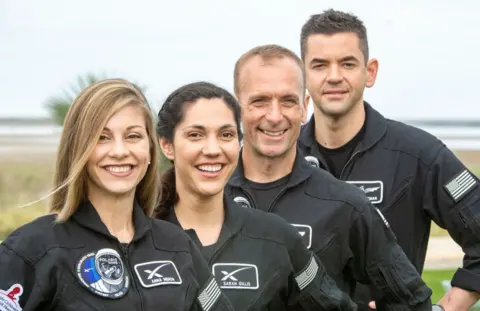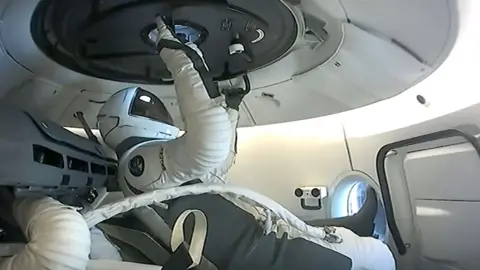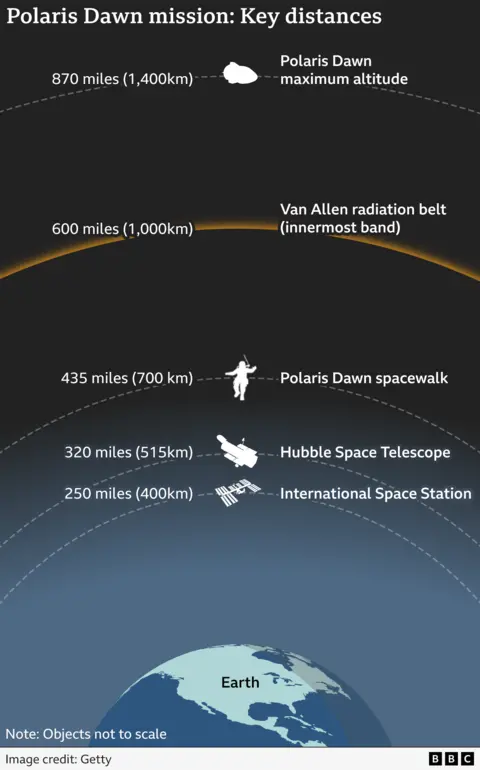A billionaire and an engineer have become the first non-professional crew to perform one of the riskiest maneuvers in space: a spacewalk.
Jared Isaacman and Sarah Gillis emerged from the SpaceX spacecraft about 15 minutes apart, starting at 11:52 BST, wearing specially designed suits.
“Back home, we all have a lot of work to do, but from here, Earth looks like a perfect world,” Mr. Isaacman said as he left.
The spacewalk was funded by Mr. Isaacman. Previously, only astronauts from government-funded space agencies had performed spacewalks.
Live footage showed the two crew members emerging from the white Dragon capsule to float 700km above the blue Earth below.
Mr. Isaacman went out first, moving his limbs, hands and feet to test his suit. He went back inside the hatch, and Ms. Gillis, who works for SpaceX, came out next.
Both crew members recounted their spacewalk, describing how their suits behaved outside the ship.
 Getty Images
Getty ImagesThe march, originally scheduled for 07:23 BST, was postponed early on Thursday.
Anticipation and tension grew as the crew prepared to open the ship’s hatch, which has no airlock, no door between the outer void and the rest of the spacecraft.
The four crew members spent two days “pre-breathing” to avoid becoming seriously ill from decompression sickness, known as “decompression sickness,” when the pressure changes. This involves replacing nitrogen in the blood with oxygen.
The craft was then depressurized to bring it closer to the conditions of outer space.
This type of spacewalk took a “very different approach” to previous spacewalks, for example from the International Space Station, according to Dr Simeon Barber, a research scientist at the Open University.
For the past few decades, astronauts have used an airlock that separates most of a craft from the vacuum of space outside — but this SpaceX Dragon capsule was indeed entirely exposed to outer space.
“It’s really exciting and I think it shows once again that SpaceX is not afraid to do things differently,” he told BBC News.
But this was not without major risks.
Mr. Isaacman, who funded the Polaris Dawn mission, was the only member of the four-person Polaris crew to have ever been to space.
He is commander of the Resilience spacecraft with his close friend Scott “Kidd” Poteet, who is a retired Air Force pilot, and two SpaceX engineers, Anna Menon and Sarah Gillis.
The Dragon capsule the team flew in has already been launched into space 46 times, carrying 50 crew members. However, the capsule and spacesuits are not subject to regulations and have not been tested in this environment.
 SpaceX
SpaceXSpacewalks are one of the most difficult maneuvers in space, so the fact that a private company has succeeded in doing so is a milestone in the history of space travel.
The 700 km (435 mile) march was higher than any previous one and used innovative technology in new astronaut suits for extravehicular activities (EVA).
This is an upgrade from SpaceX’s previous intravehicular activity (IVA) suits.
The EVA suit incorporates a heads-up display in its helmet, which provides information about the suit while in use.
Sarah Gillis read data from her heads-up display while outside the Dragon capsule.
SpaceX says the suits are comfortable and flexible enough to be worn during launch and landing, eliminating the need for separate IVA suits.
Additional nitrogen and oxygen tanks were installed and all four astronauts wore their suits, meaning the mission broke the record for the most people in the vacuum of space at the same time.
The Resilience spacecraft left Earth on Tuesday aboard a SpaceX rocket.
The mission said it would travel up to 1,400km into orbit, further than any human has been in space since the end of NASA’s Apollo programme in the 1970s.

Government space agencies like NASA want the private sector to transport their astronauts on missions and thus reduce the cost of space travel.
And entrepreneurs like Isaacman and Elon Musk want to expand private space travel so that more non-professional astronauts can go to space.
This is a major symbolic step forward, but that day is probably still a long way off as the costs remain prohibitive.
#Polaris #Dawn #Billionaire #Private #Spacewalk
